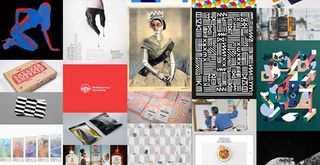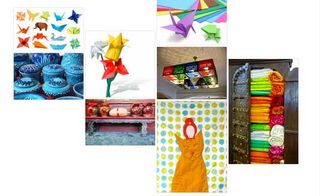Why mood boards give designers more control
Mood boards matter in the boardman, argues Jerry Cao of UXPin, and offers tips on making best use of them.

When you get to the nitty-gritty, things can get chaotic, and at times unfriendly. But in an area like UI design, "going it alone" is rarely an option.
Win clients & work smarter with our FREE ebook: get it now!
No designer is an island. Like them or hate them, you're going to need to rely on your teammates at some point in the development process. A lot of people have bad associations with working with others: having their ideas shot down, doing all the work for a lazy co-worker, enduring suck-ups and hidden agendas.
We've always felt these two quotes help capture the complete spectrum of what design collaboration can feel like:
- "Coming together is a beginning; keeping together is progress; working together is success" – Henry Ford
- "Hell is other people" – Jean-Paul Sartre
As described in Chapter 7 of the free e-book Web UI Design Best Practices, collaboration is a lot more than delegation. It's not just "you do this and I'll do this."
Collaboration is about enhancing each other's work and creating a harmony. It's following a smart plan to avoid both confusion and wasted effort. Collaboration is creating something greater as a group than would be possible for an individual.

In this article we'll discuss how to avoid design by committee and something as simple as a mood board can add collaboration into the UI design process (without cringing).
Get the Creative Bloq Newsletter
Daily design news, reviews, how-tos and more, as picked by the editors.
Committees were designed by committees
They say a camel is a horse designed by a committee. Anyone who's ever had their creative vision shot down or diluted by such a group knows how true this is.
As Speider Schneider, former product designer for ESPN, points out here, too many people believe that their opinions outweigh others, even professional experts. In a committee setting, you have an unequal distribution of aptitude but an equal distribution of power. Instead of working together to go faster in one direction, this environment encourages tearing apart in different directions.
But these are not arguments against collaboration — just design by committee. There are ways to get the benefits of working together without too many cooks in the kitchen.
How to own the design process
Andrew Follett, founder of Concept Feedback, explains that design committees are often formed for the sake of involving everyone — or to simply make it easier and more anonymous to point fingers later. There are five reasons why committees fail:
- No clearly defined objective.
- Suggestions stem from individual opinions more than facts, research, or experience.
- No strong leader.
- Feedback process is unorganized and ineffective.
- Members are furthering personal or political agendas.
Addressing these issues, then, will allow for collaboration the way it should be. Yotam Troim, director of product at Fundbox, believes that involving a few people in the design process is mandatory since very rarely will one person be able to foresee all the required changes. That being said, the design process should be owned by one person. Here's a few guidelines:
- The designer has final say — Implement a funnel of power: accept opinions from a broad range of people, but as the decisions are being made, that range of people become fewer and fewer, peaking at the designer. But this strategy only works if the designer is genuinely open to others' ideas.
- The designer must be a respected figure — Rallying around an inept leader would be just as disastrous as a committee, perhaps worse. There must be an element of trust and respect towards the designer, so that their decisions aren't shut down immediately, even if they're unpopular.
- Feedback comes in the form of a problem, not a solution — This keeps people's personal opinions in check. "The homepage doesn't show a clear next step" is a lot more helpful than "I think the home page needs a larger button…let me show you!"
- Feedback must not be vague — "I'm not feeling this," or " this doesn't excite me," are not acceptable. Worse still is the dreaded "Make it pop!" Team members should try Dustin Curtis's Three Question Rule: the critic is required to answer three questions about their comment to flesh it out.
- IDEO seems to have a knack for avoiding the common pitfalls of improper collaboration. Johnnie Manzari, UI Designer at Apple, shares an anecdote about the importance of someone making the hard decisions:
"In college I took a class from David Kelley, who ran IDEO at the time. He showed a video of the IDEO design process for making a shopping cart. During the brainstorming and research phase, the walls were filled with hundreds of different concepts. Some were wild deviations and some were slight modifications.
"They then chose three concepts to continue exploring in the prototype phase. I asked David Kelley how they went from walls full of concepts down to three and he said 'I picked. At some point you need to pick. Otherwise, it's a circus.'"
Next page: more on why mood boards give you more control

Thank you for reading 5 articles this month* Join now for unlimited access
Enjoy your first month for just £1 / $1 / €1
*Read 5 free articles per month without a subscription

Join now for unlimited access
Try first month for just £1 / $1 / €1
The Creative Bloq team is made up of a group of design fans, and has changed and evolved since Creative Bloq began back in 2012. The current website team consists of eight full-time members of staff: Editor Georgia Coggan, Deputy Editor Rosie Hilder, Ecommerce Editor Beren Neale, Senior News Editor Daniel Piper, Editor, Digital Art and 3D Ian Dean, Tech Reviews Editor Erlingur Einarsson and Ecommerce Writer Beth Nicholls and Staff Writer Natalie Fear, as well as a roster of freelancers from around the world. The 3D World and ImagineFX magazine teams also pitch in, ensuring that content from 3D World and ImagineFX is represented on Creative Bloq.
